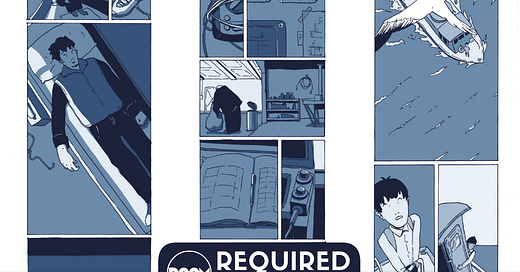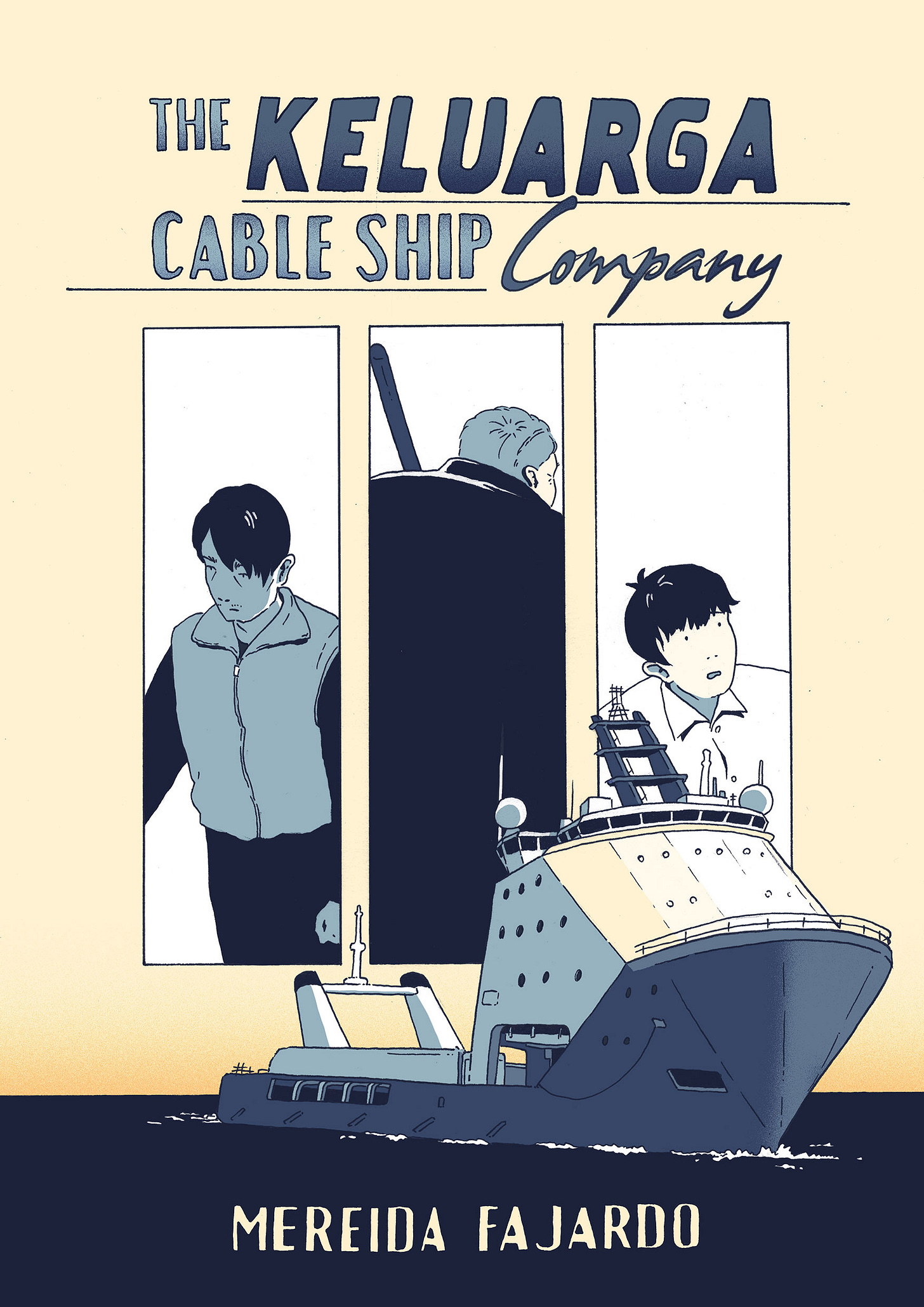The Keluarga Cable Ship Company is art as an act of inquiry
Mereida Fajardo expands the horizons of the webcomic.
Required Reading is DoomRocket's love chest, opened once a month to champion a book that we adore and you should read. The latest: Mereida Fajardo's The Keluarga Cable Ship Company, available now.
It's July 2025, and the LDC ("Laydeez Do Comics") Online Comics Fair is in full swing; in the spirit of embracing the new and modern, Mereida Fajardo gets creative with the screen medium with The Keluarga Cable Ship Company. In Keluarga, Fajardo employs the "endless scroll" digital comics format (DoomRocket devotees may recall our coverage of Dave Scheidt and Aaron Pittman's Slice, an early iteration of this), featuring three columns telling three aspects (and three perspectives) of the story at once — Fajardo's combination of writing and timing slaloming between panels in separate lanes.
Naturally, this is a story about technology and how human interaction changes over time. Put generally: Keluarga is set on a ship that repairs the underwater fiber cables we rely on to cast the Web worldwide. More specifically: a father is stationed on board, and his son — who went to university instead of following his family's footsteps — winds up working on the ship after all. A projection from the past haunts the connection between them. The vessel needs to be brought into the same century as what it repairs. And a storm is brewing.
Fajardo's layouts invite us to consider Keluarga from Michelle Abate's cartographic perspective. Instead of only considering the panels as a carrier of story, a ladder that only goes down, take the "page" as a whole and see what visual connections form outside of moving the narrative forward. What are the visual elements saying to each other? How do their subtexts interact? Sometimes speaking becomes a physical bridge from one character's story to the other's, passing off the conversation between columns. Call it a conversation; it is two people talking, but neither man is listening to the other.
I also think of Andy Warhol and Barbara Rubin and the exploding underground experimental film scene in New York. They made movies where different things were projected on separate screens, in the same room at the same time. Fajardo is thinking about comics as a medium not beholden to any existing rules to do its storytelling, and we as readers ought to try to do the same.
It's making art as an act of inquiry. How do I tell this story in a way that challenges the reader instead of guiding them? Will what I want to convey be discoverable when people can read it any way they want? What does the story need to do to make this work?
That's what the whole book is about, really: communication. Trying to make connections that cross borders. It's a bit of a tragedy as well. There are aspects of cable repair that come from being able to interpret information based on experience, a wisdom that the son lacks for having chosen a different path. But the son's path is technology, how the ship is able to repair the cable; resisting how things really are, it makes the father's wisdom a little less practical.
The other members of the crew complain about how companies like Google are putting money in the wrong places and making things run worse instead of better. You'd think, then, that the older generation would pass their knowledge on to the younger by working together. But when the unexpected comes to pass, sorry, buddy — crew only.
The art in Keluarga is spare in lines and selectively colored. A lot of dynamic angles on character shots. Repeated visual beats that play off their previous iterations. Fajardo's is almost sketchbook style, breaking down easily into shapes and blocks when the moment needs to be dynamic but is too squeezed for space/timing to have it be filled with details. The visual details are the story constantly reconnecting with itself, not an ornate aesthetic.
The layouts are alarmingly genius if you can step back from the pull of the story. The act-break lands, and hard, the plot running down the first two columns, goes boom, then silent. The blocking in every panel, though, from all three columns, is caught in the moment. Father and son and father and son and father and son are all poised in dynamic, frozen interaction, body angles and character sightlines criss-crossing the page in an angular spiral that leads the reader's eye.
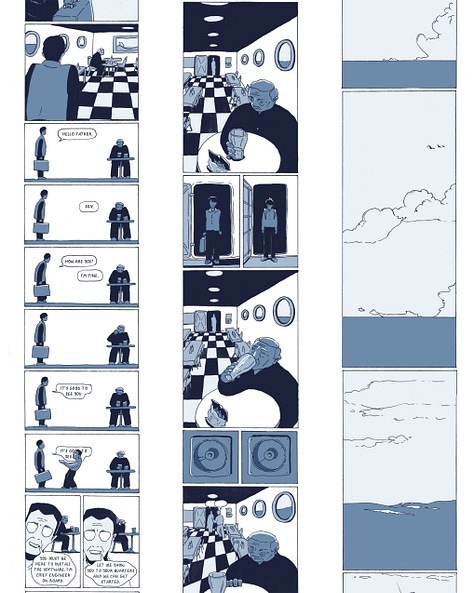
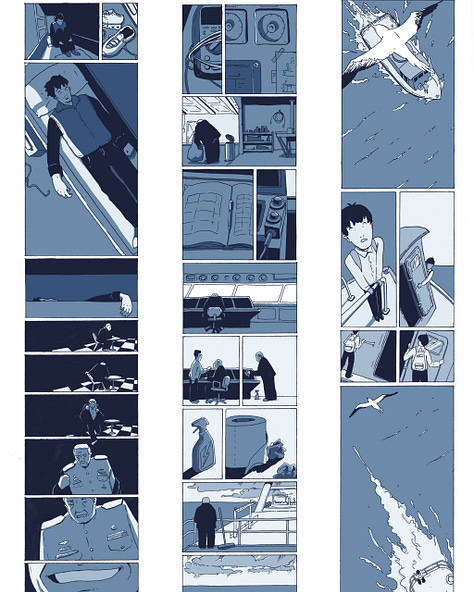
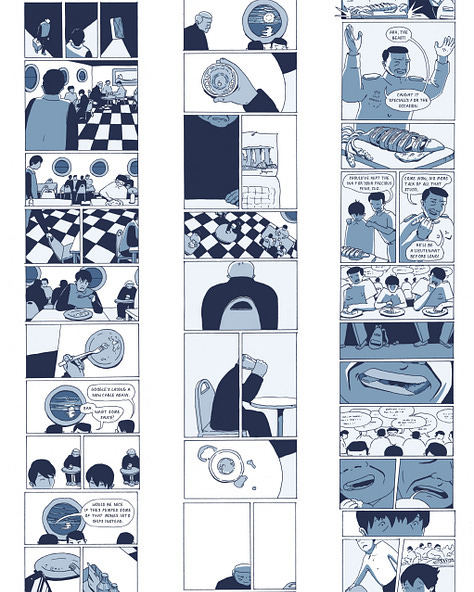
Keluarga is very effective at aligning all three columns so that emotional resonance is present everywhere at once. At first, trying to read the story in the way you traditionally read comics, I found that the first two columns seemed to be in conversation with each other, while the imagery that was "unrelated" to the story in the third column still supplemented it. Instead of a film with different parts projected across from each other, Fajardo reads like music. Harmonies rise in perpetual canon.
Everything flows between the two supposedly separate perspectives of what I've come to think of as the "main" columns. But the idea here is to challenge form, not pursue it. So, how can I read this comic wrong?
The third-column pacing felt more esoteric. With no direct interaction, the other two pass the speech bubbles back and forth and create boundaries for the narrative. It stands alone, an epilogue that is also a preamble. I read it, an echo of the contemporary story I'd gotten through so far, one that immediately and powerfully made itself felt when I returned to the top of the comic and rejoined the central narrative. Now that I've read the last column separately, finished it, it is constantly commingling with the main piece instead of being isolated, more active than ever.
The trip back and forth across the columns, and up and down the page again, is all sewn into a Möbius strip, like the emotional journey of the story itself. Tied up yet unresolved, not an echo or melody but a mirror producing a perfectly matched opposite drama. Keep going down, past the story, the ships, the last recognizable trace of man, and into the black depths beneath. At the bottom of the ocean lies a cable.
The Keluarga Cable Ship Company is available now. To read it, click this.
Self-published / £5.00 / $6.69
Written and illustrated by Mereida Fajardo.

